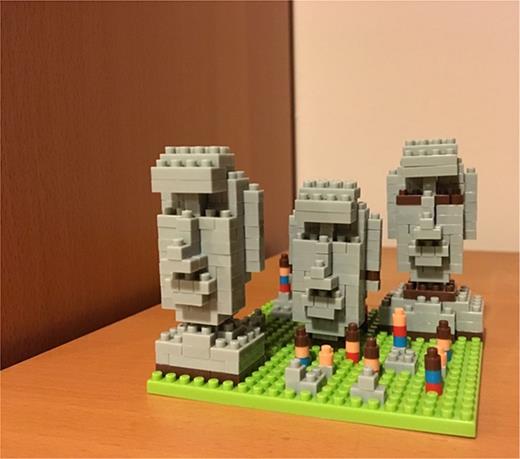In this issue of Blood, Bride et al report results of the first prospective multi-institutional trial of a long-term single-agent therapy for refractory cytopenias using rapamycin in 30 patients and show remarkable efficacy in children with autoimmune lymphoproliferative syndrome (ALPS).1
On Easter Sunday of 1772, a Dutch expedition led by Jacob Roggeveen sighted a small treeless volcanic island in the vast expanse of the southeast Pacific Ocean and named it Easter Island. That Dutch landing party and subsequent visitors to these islands, known by the locals as Rapa Nui Island, have marveled at the sight of gigantic stone figures (up to 30-feet high) of porous red rock known as moai, standing in silent rows along the shore. These statues had remained virtually isolated from the rest of humanity for a millennium. Polynesian navigators were accomplished sailors in an ancient world. Around 1500 BC, they traveled across the vast ocean guided only by stars, flight patterns of sea birds, and ocean currents; they settled every habitable island within the Polynesian triangle formed by New Zealand, Hawaii, and Easter Island. The art of Easter Island represented the supernatural power of the gods and the chiefs of the native inhabitants; enduring fascination for art historians related to oceanic folklore and sculpture art. Moai statues as exotic icons are embraced by contemporary cultures as a shared human heritage (see figure). The island’s splendid isolation has also bestowed upon the humanity an immunomodulatory agent we all readily recognize today.2 Its discoverer, Suren Sehgal, aptly named it rapamycin based on its origin from the bacteria Streptomyces hygroscopicus collected from the soil under 1 of the Rapa Nui Island statues by a Canadian expedition in 1972.3 Although it was isolated and characterized initially as an antifungal antibiotic, subsequent studies, thanks to the persistent efforts of Dr Sehgal to assess it as an anticancer agent, revealed its impressive immunosuppressive activity.4 It received US Food and Drug Administration approval for use in organ transplantation in 1999 and became more widely known by its generic name, sirolimus.5 Elucidation of the protozoal and metazoal proteins affected by this compound led to better understanding of mechanistic target of rapamycin (mTOR) signaling pathways related to growth, proliferation, and cell death in human health and disease. The MTOR gene, coding for a serine/threonine kinase (http://www.ncbi.nlm.nih.gov/gene/2475), was discovered by studying rapamycin-resistant mutants of Saccharomyces cerevisiae. Understanding of mTOR signaling has provided the biological basis for the development of several targeted therapeutics, including many rapamycin analogs currently under investigation.6
The work by Bride et al in this issue illustrates the value of studying pathophysiology-based treatments of a rare genetic disease like ALPS and applying the lessons learned to more common sporadic autoimmune problems including multilineage cytopenias. Notably, sirolimus treatment of ALPS patients with massive lymphadenopathy and splenomegaly led to reversal of the disease process itself, reflected in relief of the cytopenias and normalization of the signature double-negative T cells of ALPS in all 12 patients included in the study. No metabolic or infection-related adverse events due to sirolimus were noted in children and young adults enrolled on this trial. However, it is imperative to be wary of the toxicities that may be uncovered as more individuals including adults with normal to high normal cholesterol and lipid levels are exposed to it for the long-term as modulation of lipid metabolism is a known side effect of sirolimus.7,8 Patients with secondary multilineage cytopenias, including those due to systemic lupus erythematosus and common variable immune deficiency, were also treated with sirolimus as a long-term immunomodulatory intervention in this study, underscoring the value of sirolimus as a good steroid-sparing agent that may allow us to avoid the toxicities of long-term corticosteroids in growing children. Many ALPS patients require some immunosuppression using sirolimus, mycophenolate mofetil, or another drug indefinitely to treat their cytopenias as their underlying genetic defect is irreversible.9
Long-term management of chronic and refractory cytopenias due to sequestration or autoimmune peripheral destruction has remained empirical and eluded rational evidence-based approaches. Barring some industry-sponsored trials of thrombopoietin mimetic agents in immune thrombocytopenia, there are not many recent investigator-initiated multicenter trials enrolling children or adults with autoimmune cytopenias. With the advent of cheaper and more readily accessible genetic testing, more and more “rare” disorders of lymphoproliferation and autoimmunity are being recognized. Treatment approaches learned from ALPS and many related disorders can serve as a good model to conduct multicenter trials of targeted immunomodulation vs global immunosuppression to ameliorate pathophysiology in many of these conditions with genetic underpinnings. More often these patients are children and young adults who shall require prolonged therapy with long-lasting consequences of any intervention and they benefit from diligent longitudinal follow-up by caregivers familiar with them and their underlying disease.
Treasured soil from under the remote Rapa Nui Island statues10 in the Pacific Ocean provided us the bacteria-secreting rapamycin (sirolimus). Better understanding of the underlying pathophysiology of rare genetic diseases including ALPS offers us an opportunity to study safe and effective targeted therapeutics in collaborative multi-institutional clinical trials as exemplified by Bride et al in this issue.1
Conflict-of-interest disclosure: The author declares no competing financial interests.



